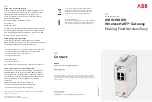
70
MultiVOIP 200 User Guide
Internet Protocol (IP)
IP is the Internet standard protocol that tracks Internetwork node addresses, routes outgoing
messages and recognizes incoming messages, allowing a message to cross multiple networks on
the way to its final destination. The IPv6 Control Protocol (IPV6CP) is responsible for configuring,
enabling, and disabling the IPv6 protocol modules on both ends of the point-to-point link. IPV6CP
uses the same packet exchange mechanism as the Link Control Protocol (LCP). IPV6CP packets are
not exchanged until PPP has reached the Network-Layer Protocol phase. IPV6CP packets received
before this phase is reached are silently discarded. (See also TCP/IP.)
Before you install TCP/IP on your network, you need to establish your Internet addressing strategy.
You first choose a domain name for your company. A domain name is the unique Internet name,
usually the name of your business, that identifies your company. For example, Multi-Tech’s domain
name is multitech.com (where .com indicates this is a commercial organization; .edu denotes
educational organizations, .gov denotes government organizations). Next, you determine how many
IP addresses you’ll need. This depends on how many individual network segments you have, and
how many systems on each segment need to be connected to the Internet. You need an IP address
for each network interface on each computer and hardware device.
IP addresses are 32 bits long and come in two types: network and host. Network addresses come in
five classes: A, B, C, D, and E. Each class of network address is allocated a certain number of host
addresses. For example, a class B network can have a maximum of 65,534 hosts, while a class C
network can have only 254. The class A and B addresses have been exhausted, and the class D and
E addresses are reserved for special use. Consequently, companies now seeking an Internet
connection are limited to class C addresses. The current demand for Internet connections will
exhaust the current stock of 32-bit IP addresses. In response, Internet architects have proposed the
next generation of IP addresses, Ipng (IP Next Generation). It will feature 16-byte addressing,
surpassing the capacities of 32-bit IP. Still in its design phase, IPng is not expected to be widely
deployed before late 1997.
An IP address can serve only a single physical network. Therefore, if your organization has multiple
physical networks, you must make them appear as one to external users. This is done via
“subnetting”, a complex procedure best left to ISPs and others experienced in IP addressing. Since
IP addresses and domain names have no inherent connection, they are mapped together in
databases stored on Domain Name Servers (DNS). If you decide to let an Internet Service Provider
(ISP) administer your DNS server, the ISP can assist you with the domain name and IP address
assignment necessary to configure your company’s site-specific system information. Domain names
and IP addresses are granted by the InterNIC. To check the availability of a specific name or to obtain
more information, call the InterNIC at (703)742-4777.
Содержание MultiVOIP 400
Страница 1: ...Standalone Voice IP Gateway Models MVP400 and MVP 800 User Guide...
Страница 5: ...Chapter 1 Introduction and Description...
Страница 14: ...14 MultiVOIP User Guide...
Страница 15: ...Chapter 2 Installation...
Страница 20: ...20 MultiVOIP User Guide...
Страница 21: ...Chapter 3 Software Loading and Configuration...
Страница 39: ...Chapter 4 MultiVOIP Software...
Страница 53: ...Chapter 5 Remote Configuration and Management...
Страница 61: ...Chapter 6 Warranty Service and Tech Support...
Страница 66: ...66 MultiVOIP User Guide...
Страница 67: ...Appendixes...
Страница 75: ...Glossary...
















































